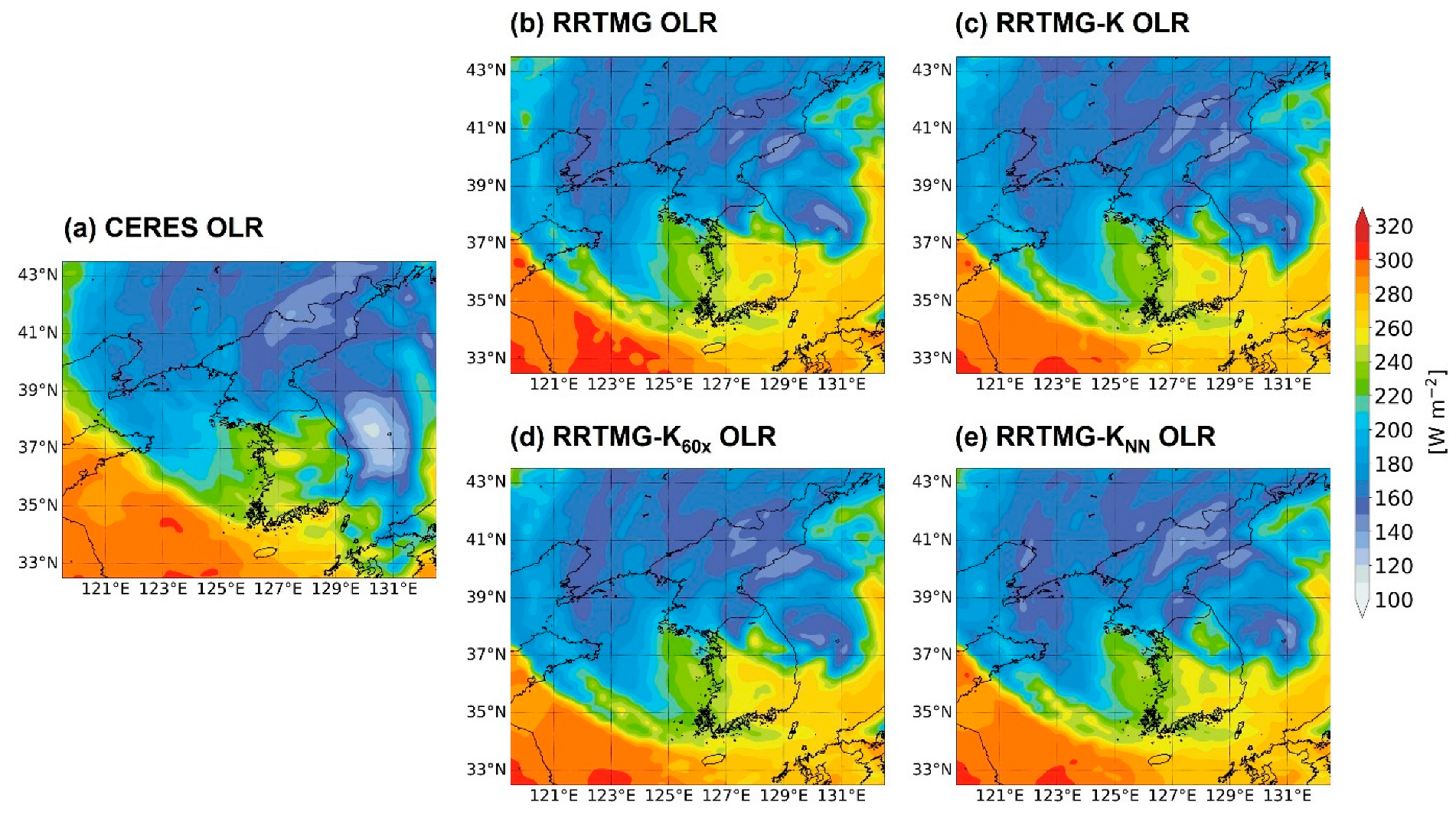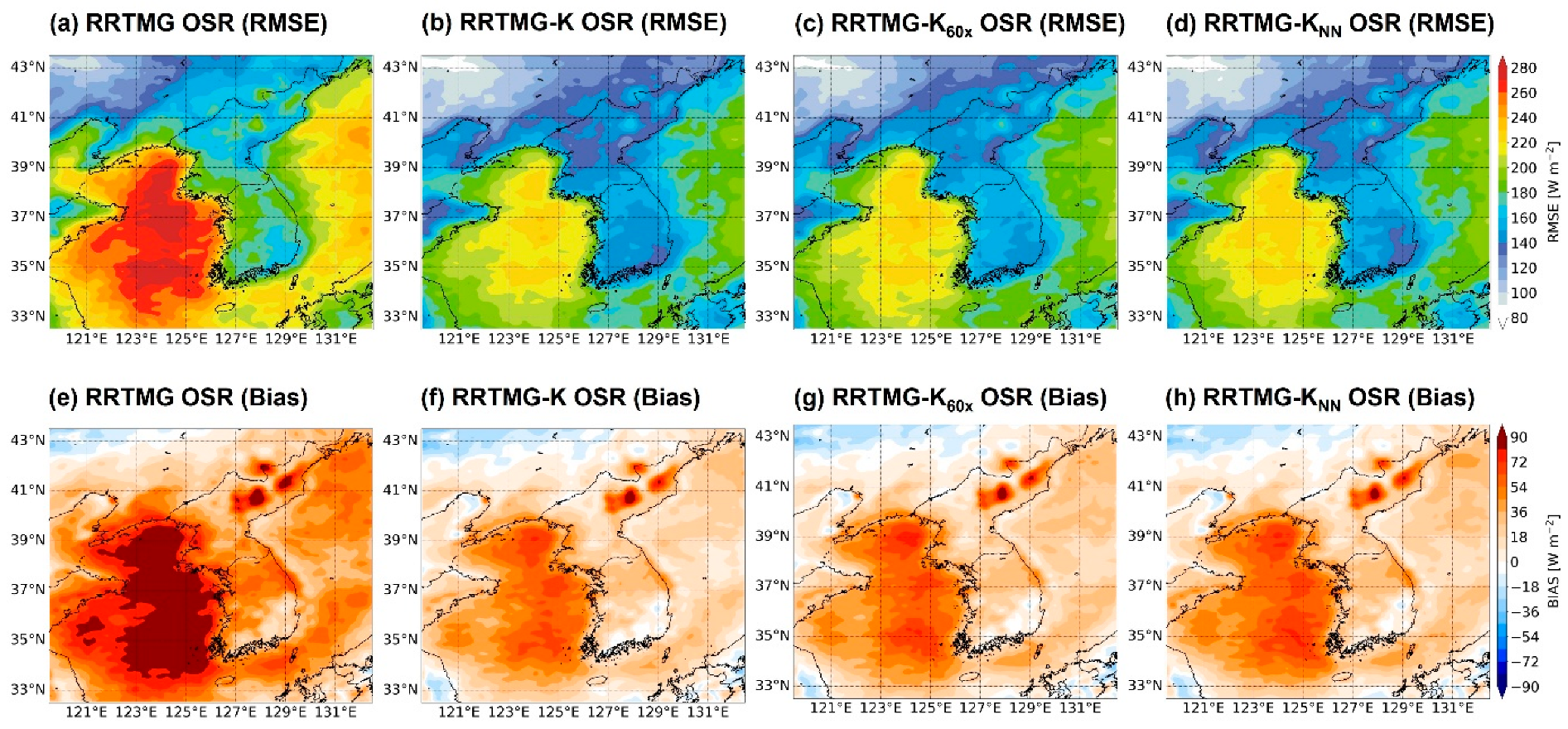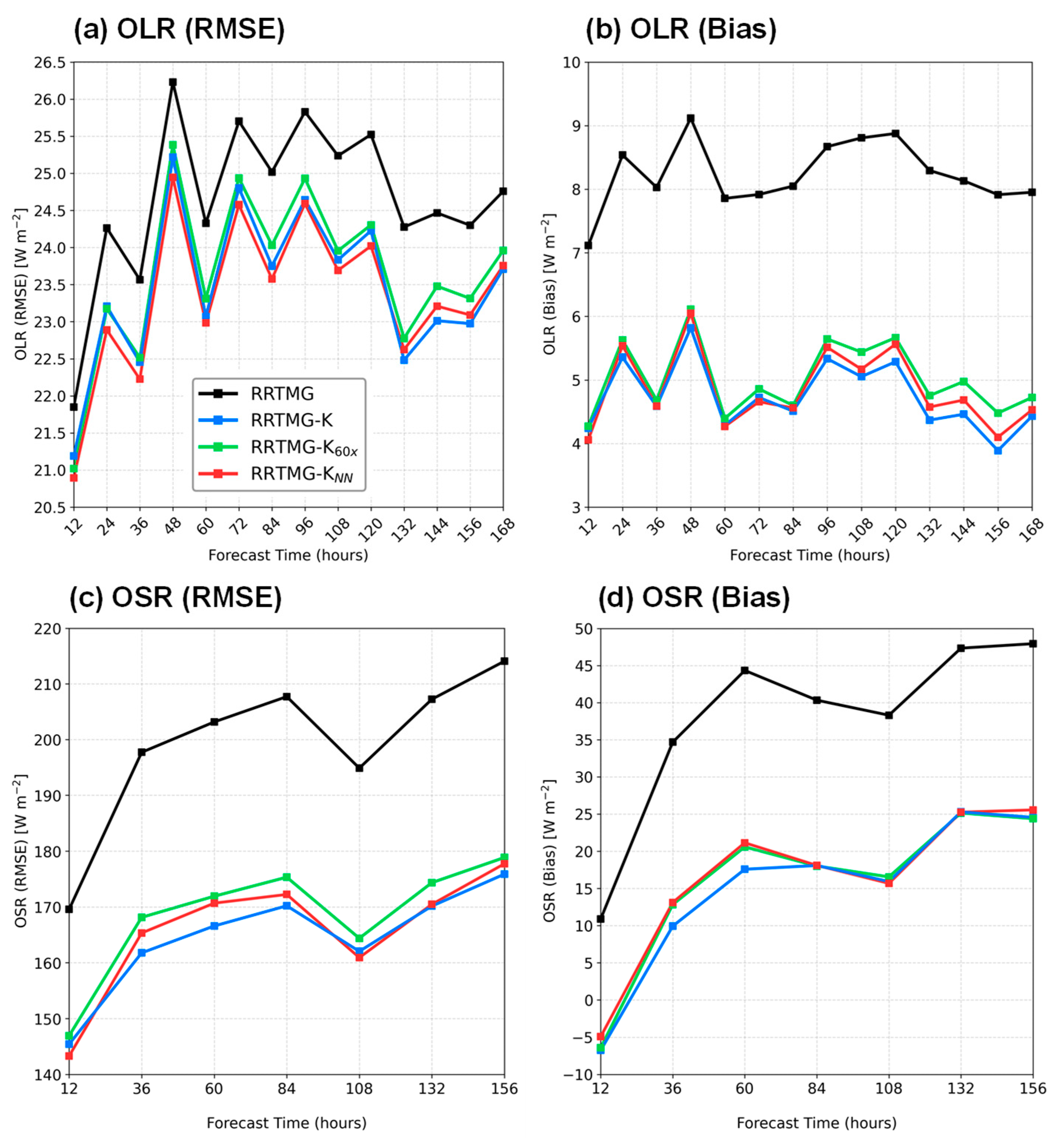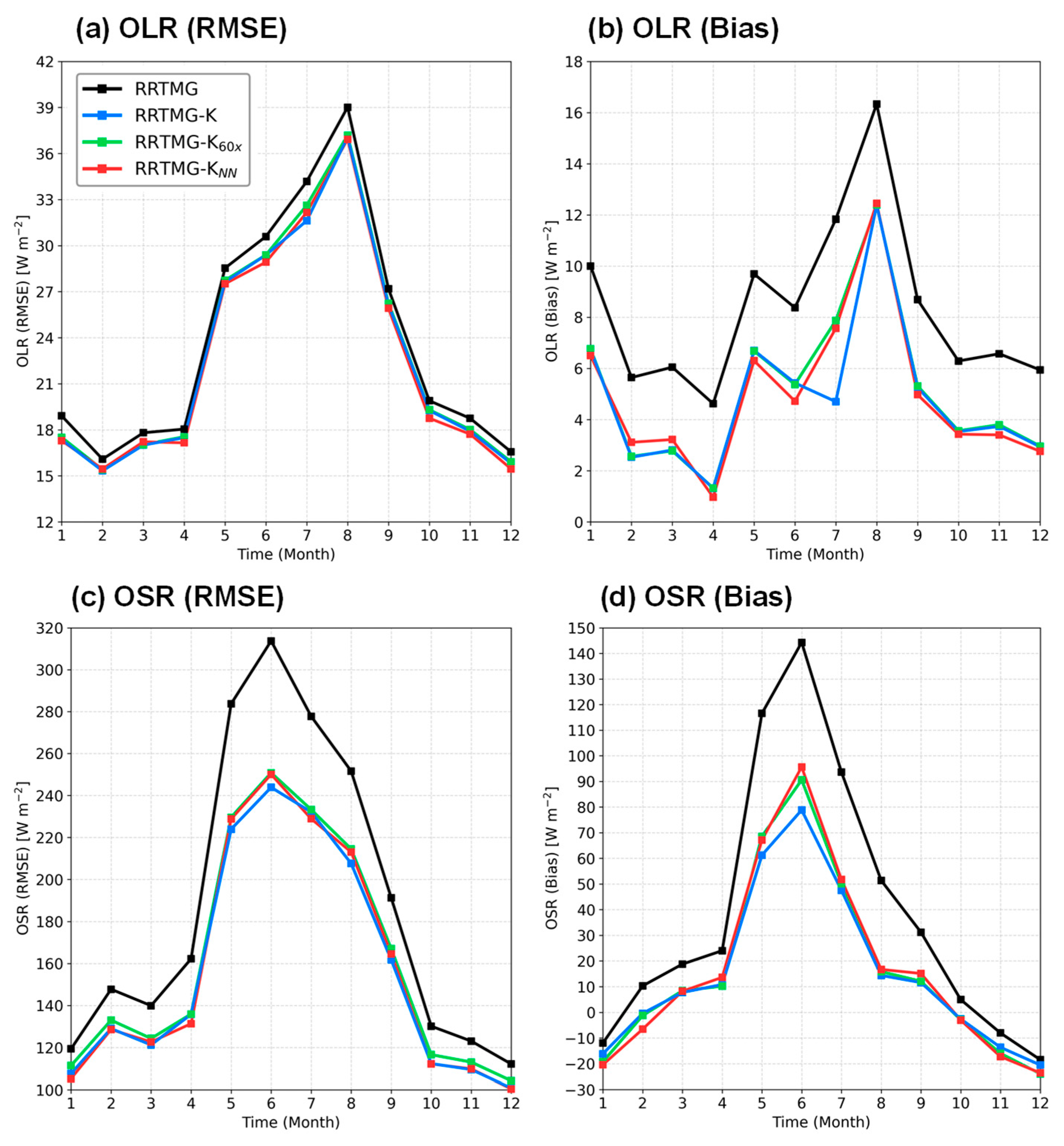An Evaluation of Radiation Parameterizations in a Meso-Scale Weather Prediction Model Using Satellite Flux Observations
Abstract
Highlights
- RRTMG-K reduced OLR RMSE by 4.8%, OSR RMSE by 17.5%, and bias by over 40% compared to RRTMG, mainly due to improved shortwave processes.
- RRTMG-KNN achieved similar or better accuracy than RRTMG-K, while offering 60-fold higher computational efficiency.
- This study is the first to validate the performance of RRTMG-K using CERES satellite fluxes in a high-resolution NWP framework.
- CERES fluxes provide a reliable benchmark for radiation scheme evaluation, and RRTMG-KNN offers a practical, fast alternative for radiative transfer.
Abstract
1. Introduction
2. Data and Methods
2.1. CERES Observations
2.2. NWP Model and Radiation Parameterization Schemes
2.3. Experimental Design and Data Collocation
3. Results
4. Discussion
5. Conclusions
Author Contributions
Funding
Data Availability Statement
Conflicts of Interest
References
- Barkstrom, B.R.; Smith, G.L. The Earth Radiation Budget Experiment: Science and implementation. Rev. Geophys. 1986, 24, 379–390. [Google Scholar] [CrossRef]
- Ramanathan, V. The role of earth radiation budget studies in climate and general circulation research. J. Geophys. Res. Atmos. 1987, 92, 4075–4095. [Google Scholar] [CrossRef]
- Harrison, E.F.; Minnis, P.; Barkstrom, B.R.; Ramanathan, V.; Cess, R.D.; Gibson, G.G. Seasonal variation of cloud radiative forcing derived from the Earth Radiation Budget Experiment. J. Geophys. Res. Atmos. 1990, 95, 18687–18703. [Google Scholar] [CrossRef]
- Yang, S.-K.; Hou, Y.-T.; Miller, A.J.; Campana, K.A. Evaluation of the Earth radiation budget in NCEP–NCAR reanalysis with ERBE. J. Clim. 1999, 12, 477–493. [Google Scholar] [CrossRef]
- Loeb, N.G.; Johnson, G.C.; Thorsen, T.J.; Lyman, J.M.; Rose, F.G.; Kato, S. Satellite and Ocean Data Reveal Marked Increase in Earth’s Heating Rate. Geophys. Res. Lett. 2021, 48, e2021GL093047. [Google Scholar] [CrossRef]
- Loeb, N.G.; Ham, S.-H.; Allan, R.P.; Thorsen, T.J.; Meyssignac, B.; Kato, S.; Johnson, G.C.; Lyman, J.M. Observational Assessment of Changes in Earth’s Energy Imbalance Since 2000. Surv. Geophys. 2024, 45, 1757–1783. [Google Scholar] [CrossRef] [PubMed]
- Wielicki, B.A.; Barkstrom, B.R.; Harrison, E.F.; Lee, R.B., III; Smith, G.L.; Cooper, J.E. Clouds and the Earth’s Radiant Energy System (CERES): An Earth Observing System experiment. Bull. Am. Meteorol. Soc. 1996, 77, 853–868. [Google Scholar] [CrossRef]
- Smith, G.L.; Priestley, K.J.; Loeb, N.G.; Wielicki, B.A.; Charlock, T.P.; Minnis, P.; Doelling, D.R.; Rutan, D.A. Clouds and Earth Radiant Energy System (CERES), a review: Past, present and future. Adv. Space Res. 2011, 48, 254–263. [Google Scholar] [CrossRef]
- Loeb, N.G.; Doelling, D.R.; Wang, H.; Su, W.; Nguyen, C.; Corbett, J.G.; Liang, L.; Mitrescu, C.; Rose, F.G.; Kato, S. Clouds and the Earth’s Radiant Energy System (CERES) Energy Balanced and Filled (EBAF) top-of-atmosphere (TOA) Edition-4.0 data product. J. Clim. 2018, 31, 895–918. [Google Scholar] [CrossRef]
- Kato, S.; Rose, F.G.; Rutan, D.A.; Thorsen, T.J.; Loeb, N.G.; Doelling, D.R.; Huang, X.; Smith, W.L.; Su, W.; Ham, S.-H. Surface irradiances of Edition 4.0 Clouds and the Earth’s Radiant Energy System (CERES) Energy Balanced and Filled (EBAF) data product. J. Clim. 2018, 31, 4501–4527. [Google Scholar] [CrossRef]
- Loeb, N.G.; Doelling, D.R.; Kato, S.; Su, W.; Mlynczak, P.E.; Wilkins, J.C. Continuity in Top-of-Atmosphere Earth Radiation Budget Observations from CERES EBAF Edition 4.2. J. Clim. 2024, 37, 6093–6108. [Google Scholar] [CrossRef]
- Liang, L.; Su, W.; Sejas, S.; Eitzen, Z.; Loeb, N.G. Next-generation radiance unfiltering process for the Clouds and the Earth’s Radiant Energy System instrument. Atmos. Meas. Tech. 2024, 17, 2147–2163. [Google Scholar] [CrossRef]
- Harries, J.E.; Russell, J.E.; Hanafin, J.A.; Brindley, H.; Futyan, J.; Rufus, J.; Kellock, S.; Matthews, G.; Wrigley, R.; Last, A.; et al. The Geostationary Earth Radiation Budget project. Bull. Am. Meteorol. Soc. 2005, 86, 945–960. [Google Scholar] [CrossRef]
- Dewitte, S.; Gonzalez, L.; Clerbaux, N.; Ipe, A.; Bertrand, C.; De Paepe, B. The Geostationary Earth Radiation Budget Edition 1 Data Processing Algorithms. Adv. Space Res. 2008, 41, 1906–1913. [Google Scholar] [CrossRef]
- Clerbaux, N.; Dewitte, S.; Bertrand, C.; Caprion, D.; De Paepe, B.; Gonzalez, L.; Ipe, A.; Russell, J.E.; Brindley, H. Unfiltering of the Geostationary Earth Radiation Budget (GERB) Data. Part I: Shortwave Radiation. J. Atmos. Ocean. Technol. 2008, 25, 1087–1105. [Google Scholar] [CrossRef]
- Kim, B.-Y.; Lee, K.-T.; Jee, J.-B.; Zo, I.-S. Retrieval of outgoing longwave radiation at top-of-atmosphere using Himawari-8 AHI data. Remote Sens. Environ. 2018, 204, 498–508. [Google Scholar] [CrossRef]
- Lee, S.-H.; Kim, B.-Y.; Lee, K.-T.; Zo, I.-S.; Jung, H.-S.; Rim, S.-H. Retrieval of reflected shortwave radiation at the top of the atmosphere using Himawari-8/AHI data. Remote Sens. 2018, 10, 213. [Google Scholar] [CrossRef]
- Zo, I.-S.; Jee, J.-B.; Lee, K.-T.; Lee, K.-H.; Lee, M.-Y.; Kwon, Y.-S. Radiative energy budget for East Asia based on GK-2A/AMI observation data. Remote Sens. 2023, 15, 1558. [Google Scholar] [CrossRef]
- Clough, S.A.; Shephard, M.W.; Mlawer, E.J.; Delamere, J.S.; Iacono, M.J.; Cady-Pereira, K.; Boukabara, S.; Brown, P.D. Atmospheric radiative transfer modeling: A summary of the AER codes. J. Quant. Spectrosc. Radiat. Transf. 2005, 91, 233–244. [Google Scholar] [CrossRef]
- Iacono, M.J.; Delamere, J.S.; Mlawer, E.J.; Shephard, M.W.; Clough, S.A.; Collins, W.D. Radiative forcing by long-lived greenhouse gases: Calculations with the AER radiative transfer models. J. Geophys. Res. Atmos. 2008, 113, D13103. [Google Scholar] [CrossRef]
- Baek, S.-H. A revised radiation package of G-packed McICA and two-stream approximation: Performance evaluation in a global weather forecasting model. J. Adv. Model. Earth Syst. 2017, 9, 1628–1640. [Google Scholar] [CrossRef]
- Hogan, R.J.; Bozzo, A. A flexible and efficient radiation scheme for the ECMWF model. J. Adv. Model. Earth Syst. 2018, 10, 1990–2008. [Google Scholar] [CrossRef]
- Eitzen, Z.A.; Su, W.; Xu, K.; Loeb, N.; Sun, M.; Doelling, D.; Rose, F.; Bodas-Salcedo, A. Evaluation of a general circulation model by the CERES Flux-by-Cloud type simulator. J. Geophys. Res. Atmos. 2017, 122, 10655–10668. [Google Scholar] [CrossRef] [PubMed]
- Rossow, W.B.; Schiffer, R.A. Advances in understanding clouds from ISCCP. Bull. Am. Meteorol. Soc. 1999, 80, 2261–2287. [Google Scholar] [CrossRef]
- Loeb, N.G.; Wang, H.; Allan, R.P.; Andrews, T.; Armour, K.; Cole, J.N.S.; Dufresne, J.; Forster, P.; Gettelman, A.; Guo, H.; et al. New generation of climate models track recent unprecedented changes in Earth’s radiation budget observed by CERES. Geophys. Res. Lett. 2020, 47, e2019GL086705. [Google Scholar] [CrossRef]
- Li, D.; Folini, D.; Wild, M. Assessment of top of atmosphere, atmospheric and surface energy budgets in CMIP6 models on regional scales. Earth Space Sci. 2023, 10, e2022EA002758. [Google Scholar] [CrossRef]
- Yuan, C.; Zhang, H.; Jing, X.; Zhao, S.; Li, X. Impact of a new radiation scheme on simulated climate in the Global–Regional Integrated SysTem model under varying physical parameterization schemes. Atmosphere 2024, 15, 501. [Google Scholar] [CrossRef]
- Pinty, B.; Lavergne, T.; Dickinson, R.E.; Widlowski, J.-L.; Gobron, N.; Verstraete, M.M. Simplifying the interaction of land surfaces with radiation for relating remote sensing products to climate models. J. Geophys. Res. Atmos. 2006, 111, D02116. [Google Scholar] [CrossRef]
- Bae, S.Y.; Park, R.-S. Consistency between the cloud and radiation processes in a numerical forecasting model. Meteorol. Atmos. Phys. 2019, 131, 1429–1436. [Google Scholar] [CrossRef]
- Hogan, R.J.; Matricardi, M. Evaluating and improving the treatment of gases in radiation schemes: The Correlated K-Distribution Model Intercomparison Project (CKDMIP). Geosci. Model Dev. 2020, 13, 6501–6521. [Google Scholar] [CrossRef]
- Roh, S.; Song, H.-J. Evaluation of neural network emulations for radiation parameterization in cloud resolving model. Geophys. Res. Lett. 2020, 47, e2020GL089444. [Google Scholar] [CrossRef]
- Zhang, H.; Zhu, S.; Zhao, S.; Wei, X. Establishment of high-resolution aerosol parameterization and its influence on radiation calculations. J. Quant. Spectrosc. Radiat. Transf. 2020, 243, 106802. [Google Scholar] [CrossRef]
- Waliser, D.E.; Graham, N.E.; Gautier, C. Comparison of the highly reflective cloud and outgoing longwave radiation datasets for use in estimating tropical deep convection. J. Clim. 1993, 6, 331–353. [Google Scholar] [CrossRef]
- Pearson, K.J.; Hogan, R.J.; Allan, R.P.; Lister, G.M.S.; Holloway, C.E. Evaluation of the model representation of the evolution of convective systems using satellite observations of outgoing longwave radiation. J. Geophys. Res. Atmos. 2010, 115, D20206. [Google Scholar] [CrossRef]
- Wiscombe, W.J. The delta-M method: Rapid yet accurate radiative flux calculations for strongly asymmetric phase functions. J. Atmos. Sci. 1977, 34, 1408–1422. [Google Scholar] [CrossRef]
- Stamnes, K.; Tsay, S.-C.; Wiscombe, W.; Jayaweera, K. Numerically stable algorithm for discrete-ordinate-method radiative transfer in multiple scattering and emitting layered media. Appl. Opt. 1988, 27, 2502–2509. [Google Scholar] [CrossRef]
- Pauluis, O.; Emanuel, K. Numerical instability resulting from infrequent calculation of radiative heating. Mon. Weather Rev. 2004, 132, 673–686. [Google Scholar] [CrossRef]
- Pincus, R.; Stevens, B. Paths to accuracy for radiation parameterizations in atmospheric models. J. Adv. Model. Earth Syst. 2013, 5, 225–233. [Google Scholar] [CrossRef]
- Song, H.-J.; Roh, S. Improved weather forecasting using neural network emulation for radiation parameterization. J. Adv. Model. Earth Syst. 2021, 13, e2021MS002609. [Google Scholar] [CrossRef]
- Song, H.J.; Roh, S.; Lee, J.; Nam, G.; Yun, E.; Yoon, J.; Kim, P.S. Benefits of stochastic weight averaging in developing neural network radiation scheme for numerical weather prediction. J. Adv. Model. Earth Syst. 2022, 14, e2021MS002921. [Google Scholar] [CrossRef]
- Song, H.-J.; Roh, S.; Park, H. Compound parameterization to improve the accuracy of radiation emulator in a numerical weather prediction model. Geophys. Res. Lett. 2021, 48, e2021GL095043. [Google Scholar] [CrossRef]
- Kim, P.S.; Song, H.-J. Usefulness of automatic hyperparameter optimization in developing radiation emulator in a numerical weather prediction model. Atmosphere 2022, 13, 721. [Google Scholar] [CrossRef]
- Song, H.-J.; Kim, P.S. Effects of cloud microphysics on the universal performance of neural network radiation scheme. Geophys. Res. Lett. 2022, 49, e2022GL098601. [Google Scholar] [CrossRef]
- Song, H.-J.; Roh, S. Impact of horizontal resolution on the robustness of radiation emulators in a numerical weather prediction model. Remote Sens. 2023, 15, 2637. [Google Scholar] [CrossRef]
- Roh, S.; Kim, P.S.; Song, H.-J. Streamlining hyperparameter optimization for radiation emulator training with automated Sherpa. Geosci. Lett. 2024, 11, 19. [Google Scholar] [CrossRef]
- Su, W.; Corbett, J.; Eitzen, Z.; Liang, L. Next-generation angular distribution models for top-of-atmosphere radiative flux calculation from CERES instruments: Methodology. Atmos. Meas. Tech. 2015, 8, 611–632. [Google Scholar] [CrossRef]
- Shin, H.-C.; Ha, J.-H.; Ahn, K.D.; Lee, E.H.; Kim, C.H.; Lee, Y.H.; Clayton, A. An overview of KMA’s operational NWP data assimilation systems. In Data Assimilation for Atmospheric, Oceanic and Hydrologic Applications; Park, S.K., Xu, L., Eds.; Springer: Cham, Switzerland, 2022; Volume IV, pp. 1–30. [Google Scholar] [CrossRef]
- Skamarock, W.C.; Klemp, J.B.; Dudhia, J.; Gill, D.O.; Zhiquan, L.; Berner, J.; Wang, W.; Powers, J.G.; Duda, M.G.; Barker, D.M.; et al. A Description of the Advanced Research WRF Model Version 4; NCAR Tech. Note NCAR/TN-556+STR; National Center for Atmospheric Research: Boulder, CO, USA, 2019. [Google Scholar] [CrossRef]
- Hersbach, H.; Bell, B.; Berrisford, P.; Hirahara, S.; Horányi, A.; Muñoz-Sabater, J.; Nicolas, J.; Peubey, C.; Radu, R.; Schepers, D.; et al. The ERA5 global reanalysis. Q. J. R. Meteorol. Soc. 2020, 146, 1999–2049. [Google Scholar] [CrossRef]
- Belochitski, A.; Krasnopolsky, V. Robustness of Neural Network Emulations of Radiative Transfer Parameterizations in a State-of-the-Art General Circulation Model. Geosci. Model Dev. 2021, 14, 7425–7437. [Google Scholar] [CrossRef]
- Saunders, R.; Hocking, J.; Turner, E.; Rayer, P.; Rundle, D.; Brunel, P.; Vidot, J.; Roquet, P.; Matricardi, M.; Geer, A.; et al. An Update on the RTTOV Fast Radiative Transfer Model (currently version 12). Geosci. Model Dev. 2018, 11, 2717–2737. [Google Scholar] [CrossRef]
- Izmailov, P.; Podoprikhin, D.; Garipov, T.; Vetrov, D.; Wilson, A.G. Averaging weights leads to wider optima and better generalization. In Proceedings of the Conference on Uncertainty in Artificial Intelligence (UAI), Monterey, CA, USA, 6–10 August 2018; Available online: https://arxiv.org/abs/1803.05407 (accessed on 23 September 2025).
- Matus, A.V.; L’Ecuyer, T.S. The Role of Cloud Phase in Earth’s Radiation Budget. J. Geophys. Res. Atmos. 2017, 122, 2559–2578. [Google Scholar] [CrossRef]
- Bodas-Salcedo, A.; Williams, K.D.; Ringer, M.A.; Beau, I.; Cole, J.N.S.; Dufresne, J.-L.; Koshiro, T.; Stevens, B.; Wang, Z. Large Contribution of Supercooled Liquid Clouds to the Solar Radiation Budget of the Southern Ocean. J. Clim. 2016, 29, 4213–4228. [Google Scholar] [CrossRef]
- Li, J.; Yi, Y.; Minnis, P.; Huang, J.; Yan, H.; Ma, Y.; Wang, W.; Ayers, J.K. Radiative Effect Differences between Multi-Layered and Single-Layer Clouds Derived from CERES, CALIPSO, and CloudSat Data. J. Quant. Spectrosc. Radiat. Transf. 2011, 112, 361–375. [Google Scholar] [CrossRef]
- Gallucci, D.; Romano, F.; Cersosimo, A.; Cimini, D.; Di Paola, F.; Gentile, S.; Geraldi, E.; Larosa, S.; Nilo, S.T.; Ricciardelli, E.; et al. Nowcasting Surface Solar Irradiance with AMESIS via Motion Vector Fields of MSG-SEVIRI Data. Remote Sens. 2018, 10, 845. [Google Scholar] [CrossRef]
- Kosmopoulos, P.; Dhake, H.; Melita, N.; Tagarakis, K.; Georgakis, A.; Stefas, A.; Vaggelis, O.; Korre, V.; Kashyap, Y. Multi-Layer Cloud Motion Vector Forecasting for Solar Energy Applications. Appl. Energy 2024, 353, 122144. [Google Scholar] [CrossRef]









| Radiation Schemes | radt | Computation Time |
|---|---|---|
| RRTMG | 20 s | 100 |
| RRTMG-K | 20 s | 86 |
| RRTMG-K60x | 20 min | 1.43 |
| RRTMG-KNN | 20 s | 1.43 |
Disclaimer/Publisher’s Note: The statements, opinions and data contained in all publications are solely those of the individual author(s) and contributor(s) and not of MDPI and/or the editor(s). MDPI and/or the editor(s) disclaim responsibility for any injury to people or property resulting from any ideas, methods, instructions or products referred to in the content. |
© 2025 by the authors. Licensee MDPI, Basel, Switzerland. This article is an open access article distributed under the terms and conditions of the Creative Commons Attribution (CC BY) license (https://creativecommons.org/licenses/by/4.0/).
Share and Cite
Choi, J.; Roh, S.; Song, H.-J.; Baek, S.; Choi, M.; Choi, W.-J. An Evaluation of Radiation Parameterizations in a Meso-Scale Weather Prediction Model Using Satellite Flux Observations. Remote Sens. 2025, 17, 3312. https://doi.org/10.3390/rs17193312
Choi J, Roh S, Song H-J, Baek S, Choi M, Choi W-J. An Evaluation of Radiation Parameterizations in a Meso-Scale Weather Prediction Model Using Satellite Flux Observations. Remote Sensing. 2025; 17(19):3312. https://doi.org/10.3390/rs17193312
Chicago/Turabian StyleChoi, Jihee, Soonyoung Roh, Hwan-Jin Song, Sunghye Baek, Minjin Choi, and Won-Jun Choi. 2025. "An Evaluation of Radiation Parameterizations in a Meso-Scale Weather Prediction Model Using Satellite Flux Observations" Remote Sensing 17, no. 19: 3312. https://doi.org/10.3390/rs17193312
APA StyleChoi, J., Roh, S., Song, H.-J., Baek, S., Choi, M., & Choi, W.-J. (2025). An Evaluation of Radiation Parameterizations in a Meso-Scale Weather Prediction Model Using Satellite Flux Observations. Remote Sensing, 17(19), 3312. https://doi.org/10.3390/rs17193312






